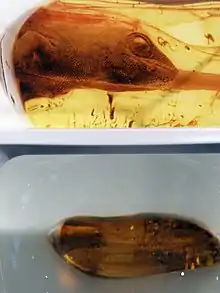Yantarogekko
Yantarogekko is an extinct genus of gecko known from a single specimen found trapped in Eocene-aged Baltic amber[1] The remains consist of the anterior half of a body with partially preserved limbs (including preserved toe pads on one limb), lacking a skeleton.[2] While considered in its initial description to be a member of the family Gekkonidae,[1] the limited nature of known remains combined with its morphology not closely resembling any living family of geckos make it impossible to assign it any more precisely than Gekkonoidea.[3]
| Yantarogekko Temporal range: | |
|---|---|
 | |
| Scientific classification | |
| Domain: | Eukaryota |
| Kingdom: | Animalia |
| Phylum: | Chordata |
| Class: | Reptilia |
| Order: | Squamata |
| Infraorder: | Gekkota |
| Genus: | †Yantarogekko Bauer et al., 2005 |
| Species: | †Y. balticus |
| Binomial name | |
| †Yantarogekko balticus Bauer et al., 2005 | |
References
- Bauer, Aaron M.; Böhme, Wolfgang; Weitschat, Wolfgang (2005). "An Early Eocene gecko from Baltic amber and its implications for the evolution of gecko adhesion". Journal of Zoology. 265 (4): 327–332. doi:10.1017/S0952836904006259. ISSN 0952-8369.
- Bauer, A M (2019-07-01). "Gecko Adhesion in Space and Time: A Phylogenetic Perspective on the Scansorial Success Story". Integrative and Comparative Biology. 59 (1): 117–130. doi:10.1093/icb/icz020. ISSN 1540-7063. PMID 30938766.
- Daza, Juan D.; Bauer, Aaron M.; Snively, Eric D. (March 2014). "On the Fossil Record of the Gekkota: Gekkotan Fossil Record". The Anatomical Record. 297 (3): 433–462. doi:10.1002/ar.22856. PMID 24482344.
This article is issued from Wikipedia. The text is licensed under Creative Commons - Attribution - Sharealike. Additional terms may apply for the media files.